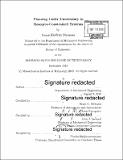Planning under uncertainty in resource-constrained systems
Author(s)
Strawser, Daniel DeWitt.
Download1139519514-MIT.pdf (29.71Mb)
Other Contributors
Massachusetts Institute of Technology. Department of Mechanical Engineering.
Advisor
Brian C. Williams.
Terms of use
Metadata
Show full item recordAbstract
As autonomous systems become integrated into the real world, planning under uncertainty is a critical task. The real world is incredibly complex and systems must reason about factors such as uncertainty in their movements, environments, and human behavior. In the face of this uncertainty, agents must compute control trajectories and policies that enable them to maximize their expected performance while respecting probabilities on mission failure. The task is difficult because systems must reason about large numbers of scenarios concerning what may happen. Compounding the difficulty, many systems must reason about uncertainty while being resource-constrained. Autonomous cars and robots are time-limited because they must react quickly to their environment. Applications such as smart grids are computationally-limited because they require low-cost hardware in order to keep energy cheap. Because of its importance to real world applications, a large amount of work has been devoted to planning under uncertainty. However, few applications focus on the resource-limited case. In time-constrained applications such as motion planning under uncertainty, methods typically focus on simplistic cost functions and models of the environment, dynamics, and stochasticity. In computation-constrained applications such as resource allocation for smart grids, approaches require computationally-intensive solvers that are unsuitable when system cost must be kept to a minimum. In both cases, the prior art is inadequate for real world demands. In this thesis, I develop a series of algorithms that enable resource-constrained systems to better plan under uncertainty. First, my work enables time-constrained systems to better approximate expected cost, search in non-convex regions, and reason about more complicated environmental geometries and agent dynamics. Additionally, I propose algorithms that enable resource allocation under uncertainty on ultra low-cost hardware by distributing computation and approximating state uncertainty through a discretization. In the time-constrained case, I model the problem of motion planning under uncertainty as a hybrid search that consists of an upper level region planner and a lower level motion planner. First, I present a method for quickly computing expected path cost and that is able to vary the precision with which the stochastic model is evaluated as required by the search. Next, I present the Fast Obstacle eXploration (FOX) algorithm that quickly generates a constraint graph for the region planner from complex obstacle geometries. I present a method for integrating CDF-based chance constraints with FOX as well as a method to model the collision probability of agents with non-trivial geometry. The latter algorithm transforms a complex problem in numerical integration into a simpler problem in computational geometry; importantly, the algorithm allows for massive parallelization on GPUs. Finally, this part concludes with the Shooting Method Monte Carlo (SMMC) algorithm. This algorithm models the chance constraint of dynamical systems with non-Gaussian state uncertainty. SMMC combines a shooting trajectory optimization with Monte Carlo simulation to approximate the collision probability for nonlinear dynamical systems. In the computation-constrained case, I develop a set of resource-allocation algorithms that are able to reason about uncertainty while being implementable on ultra low-cost hardware. A market for reliability algorithm is presented that solves resource allocation under uncertainty by allowing a distributed set of agents to bid for reliability. A centralized planner is also presented where the resource allocation problem is modeled as a Markov Decision Process and a stochastic local search used to compute good policies. The approaches for resource-constrained planning under uncertainty are bench-marked against a variety of test cases. In the motion planning domain, test cases are presented using linear dynamical systems, a Dubins car model, and a Slocum glider AUV. The method for bounding expected cost is shown to perform well against a sampling-based approach. The approach to dealing with complex obstacle geometry is shown to reach better solutions more quickly than a sampling-based RRT approach and disjunctive linear program. The sampling-based collocation method is shown to better approximate trajectory risk in simulation than a CDF-based model. Likewise, Shooting Method Monte Carlo is shown to better approximate trajectory risk than a sampling-based collocation method. In both sampling-based cases, GPU parallelization is shown to help scale computation of the chance constraint to large numbers of samples versus CPU-based computation. In the resource allocation case, the distributed and centralized contingency planners are benchmarked against mixed integer linear programs (MILP) and are shown to achieve comparable performance with a much smaller computational footprint.
Description
Thesis: Ph. D., Massachusetts Institute of Technology, Department of Mechanical Engineering, 2019 Cataloged from PDF version of thesis. Includes bibliographical references (pages 267-276).
Date issued
2019Department
Massachusetts Institute of Technology. Department of Mechanical EngineeringPublisher
Massachusetts Institute of Technology
Keywords
Mechanical Engineering.